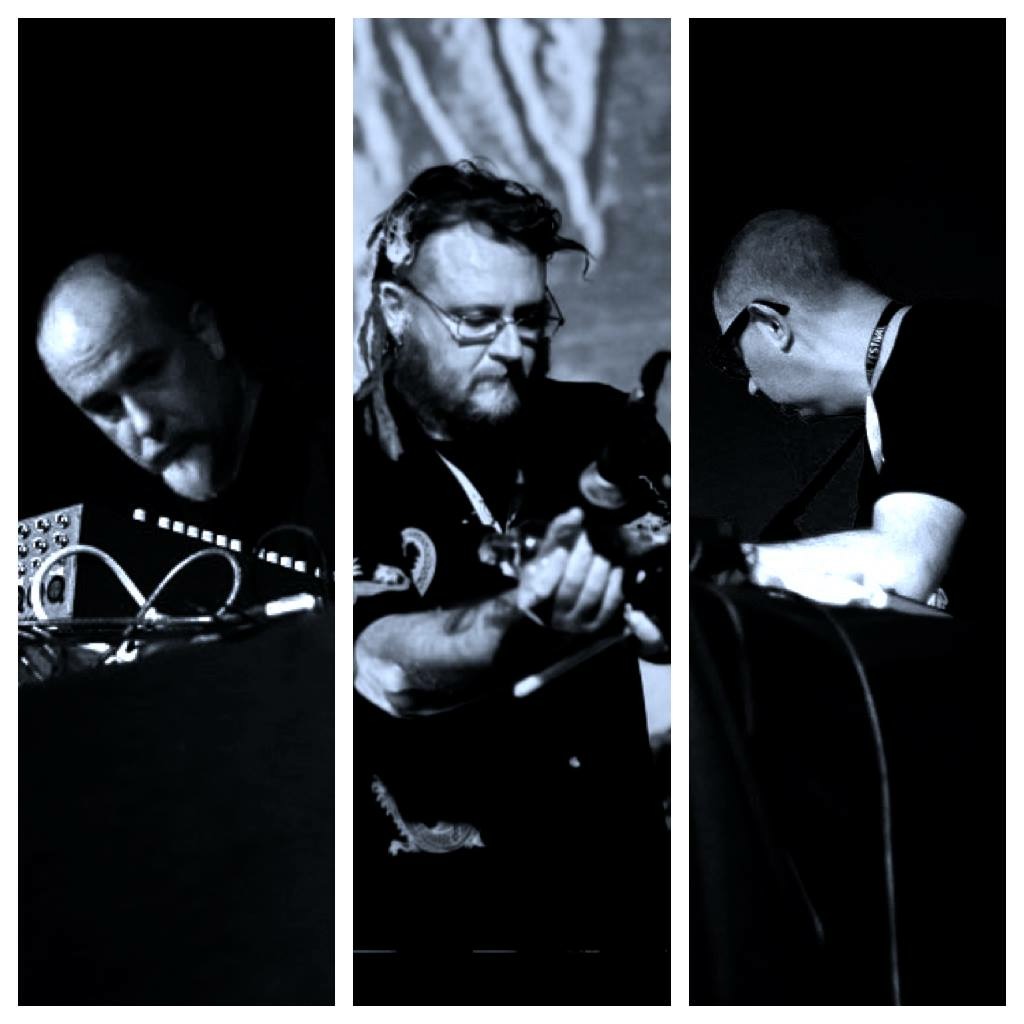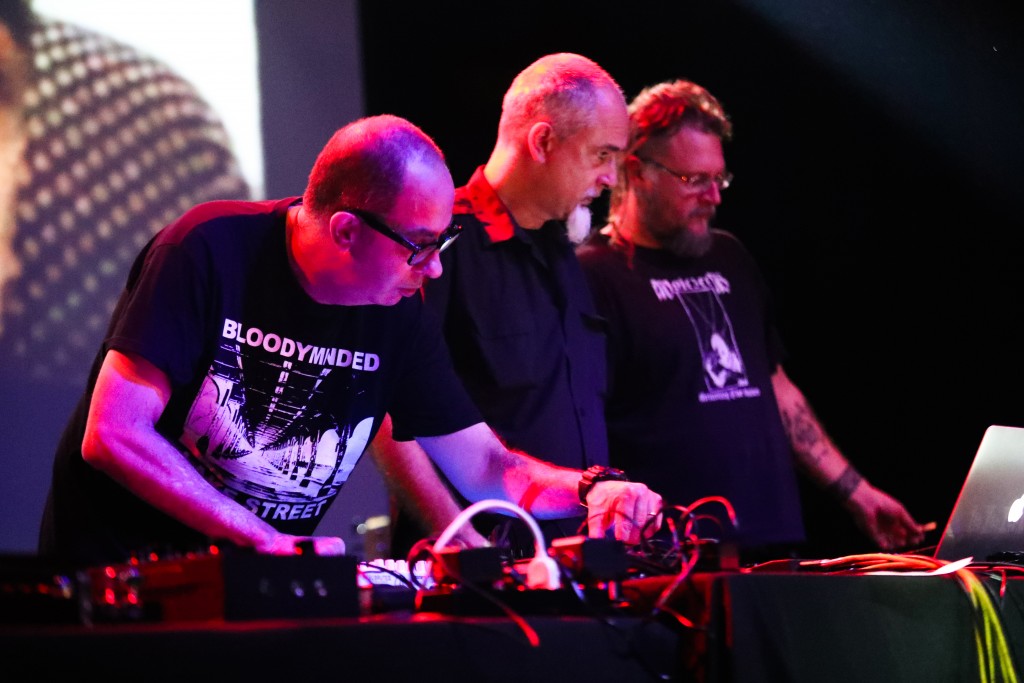Published by Davide Pappalardo on June 9, 2022
 Interview written on June 2, 2022
Interview written on June 2, 2022
Photo credits: Stefano Masselli
(PLB = Paolo L. Bandera, EB = Eraldo Bernocchi, BD = Bruno Dorella)
First of all, welcome on Flux and thank you for this interview. Your last work “Coalescence of Time: Other Conjectures on Future” is a modern example of your style, characterized by strong rhythmic elements and dark ambient textures, as well as contemporary electronics and even deconstructed guitar riffs. It’s interesting how it sounds a product of its time and place, but at the same time it fits in your ever-going sonic discourse keeping a “ritualistic” side. Would you like to tell us about its conception and themes?
PLB: in very practical terms, we have been consciously trying to push even further our comfort zone by approaching the new album in a different way than in the past… in July 2019, we went together in the Shelter studio in London and started recording Bruno on live drums, while Eraldo and I were dueling on his beats with our electronics… the idea was to explicitly merge our obsession for noise textures and deep atmospheric with a rhythmic infrastructure, in order to create a series of hypnotic mindsets and distort time perception.
Said in another way, a parallel process of continuous feedback among patterns…. we then let it rest for a few months and then Eraldo started streamlining the original raw structures and triggering our usual back and forth towards the final form… which is indeed what you mention… Sigillum S for 2022 and beyond.
Sigillum S has been active for almost forty years, an impressive amount of time for any artistic outfit, let alone an experimental project with post-industrial roots that see its origins in the 80s Italian scene. How did you get in contact with this kind of sound? What did prompt you to follow this personal path instead of, let’s say for the sake of citing genres that still obsess Italian underground today, the more popular post-punk and darkwave scenes?
PLB: it started in December 1985, when Eraldo and I met after I had seen an ad in a Milano record store where he (together with Luca Di Giorgio) was looking for people interested to explore the post-industrial underground of the time….by chance, we found out that we were, unknown to each other, both associated with the Italian branch of the Temple Of Psychic Youth and (maybe even more importantly) we were speaking the same musical language…. love for experiments, strong volumes, extreme frequencies, provocation, esoteric climates, exotic environments, fringe technology… and it never stopped since then, simply following our own trail in the same context where we were already individually, that is a path inspired by the original Industrial Culture mavericks, but fiercely pursuing own visions.
EB: as Paolo said we met through an ad. I was also into (as Paolo) dark wave and post punk, I actually still listen to it from time to time, but every time I was approaching a genre that had a formal contiguity with the “song” approach I was getting bored in a snap. I was needing something else, total freedom, no barriers. It hasn’t been a conscious decision to follow this path, it just happened to trigger all the points we were researching at that time so we quite soon discovered that conceptually and sonically we were aiming toward the very same territory.
BD: as I’m the “new” member of the posse, I have a little story about these guys. In 1992 I was a 19-years-old trainee for an Italian newspaper, and I was doing research work about the Italian underground music scene. A local label gave me some promos (vinyl, at the time) but without any press kit. One of them was a record that has been a mystery to me for years. It was called “Sigillum S / Outoffbody Experience”. I had no idea what it was, and it was my first electronic music record. The music contained was absolutely unbelievable to my ears, exciting and scary at the same time. Only a few years later, thanx to this new thing called Internet, I discovered it was a split between two bands. Curiously, in 2015 both Sigillum S and one member of Outoffbody Experience asked me to start collaborating, without knowing this little story. So here I am. A fan-kid that’s now part of the thing.
Your vast discography comprehends a plethora of releases exploring different facets of what is generalized as post-industrial music. Noise, dark-ambient, eerie and meditative soundscapes, even electronics found place in your compositions; at the same time, you keep an undeniable essence which permeates all of your work with a strong inner coherence. What do you think it’s the core and main theme of Sigillum S?
PLB: besides what I already mentioned, our essential core lies in the quest for the unknown, an unsatiable lust for new perspectives and territories, while constantly incapsulating and re-metabolizing everything we have done in the past.
Sigillum S is almost an autonomous entity which feeds from the energy created by our individual interactions, thus driving “by definition” into complex areas, but keeping a distinct character, defined by the multiple points of view of our dialogue.
Then, I am always trying to provide a conceptual framework, but this is just an aspect of a very profound, wild and mutant organism.
EB: Sigillum S became an autonomous sound/culture zone. It lives by itself, and feeds on our experiences as well as the external world. It’s constantly changing ad mutating, some of his aspects are completely detached from our will or choices. They simply happen. Sometimes they disappear and resurface years later under a different form, even if the concept is the same. In a word, Sigillum S is the constant merging of our inner parameters with the external world stimulation. It’ll always change but, as you mentioned, maintain a coherent form.
BD: this is something that links me to these two guys. An endless, pantagruelic curiosity for music, and a very little concern about genres and public’s expectations. We go wherever we feel like going, wherever Sigillum S brings us. Our coherence is evolving, not staying in a comfort zone where you make the same album over and over and people will keep on buying it.
Underground/experimental music in a post-internet era: do you think this categorization still makes sense today in an epoch where everything is easily at hand for any listener, and where the crossing of different genres and styles is a common practice?
PLB: indeed, these categories may make little sense today, because of what you mention, but at the same time, attitude and approach play a very important role… I personally think that we are still very much creating novel musical shapes and doing so outside of the mainstream, so (taking also in consideration we were kids in the 70s/80s, with consequent mindsets from that period) I still like to use the “experimental & underground” terms.
EB: I really don’t know; they can be used according to the environment and the situation. Everything is so deeply fluid nowadays that categorizing is an exercise in patience and syntactic discovery. We are surely still underground after all these years but then…what actually does “underground” mean? Which meaning are we willing to attribute to this word? How does the term “experimental” design what we do, as well as other artists?
One can only imagine that such music as yours is perfect for live performances, probably the best setting to express both sonically and visually your aesthetics and themes. Unfortunately, live shows had been on stop until recently due to a global pandemic and many artists suffered from the impossibility of performing live, both mentally and economically. What does a live performance mean to you? How did you cope with the aforementioned situation?
PLB: it really depends on what we are talking about: I will also leave the others to comment on how each of us has been coping… but a live performance is certainly one the best way to manifest Sigillum S, because of the possibilities offered by high volume and large scale, as well as the wicked unpredictability of our improvised sections. We have just gone back to playing live (May 13, 2022, in Pordenone for the Old Europa Congress) and we certainly enjoyed it a lot!
EB: I love playing live and Sigillum S are at ease on stage. Playing live has always been a ritual, at least for me. In my own planet the live dimension of things should induce the audience in a trance like state, detaching their conscience from the real world through the use of sound, structures and chaos… at least in my dreams… sometimes we managed to obtain this result.
BD: I personally never really stop playing shows during the pandemic, because I play in many different projects, and when some countries were “closed” some others were “open”, so my only real stop was March-May 2020. Playing live is the reason why we all do this, it’s necessary. But keep in mind that a live performance by Sigillum S is always very different from the album. The structures are the same, but they’re always open, and there is a good 50% of improvisation on stage. We don’t just go there and press “play”…
What does the future hold for Sigillum S? Do you have already plan for future releases, concerts, or any kind of artistic endeavors?
PLB: first of all, we will be trying to bring the new live set (entirely based on “Coalescence…”) to as many places as possible… then, we are working on some major re-issues (certainly “Bardo Thos-Grol” as expanded, double vinyl) … while, of course, pursuing all of our other projects. Then, next year we are probably going to think about new recordings, but we will see…
EB: new gigs, new recording, reprints. We never stop.
Thank you again for your time. Anything you would like to add for our readers?
PLB: time is everything and nothing… it never stops, but it goes everywhere and nowhere…. sooner, rather than later, an imagined state where everything is perfect will surface.
EB: never ever stop exploring.


